Gain Equalization (or Flattening) Filters
This type of filter has many applications. For example, for visible wavelengths 380-780 nm, a filter could be constructed to convert any continuous-spectrum illuminant into white light; e.g., light from an ordinary light bulb could be filtered to produce almost pure white light.
An introduction of the design of this filter can be found in the paper
-
M. Tilsch, C.A. Hulse, K.D. Hendrix, R.B. Sargent, "Design and demonstration of a thin-film
based gain equalization filter for C-band EDFAs", presented at the 1999 NFOEC conference.
The plot below shows the relative intensity of the EDFA output. If this were plotted on the logarithmic dB scale, the output would have a range of 8 dB.
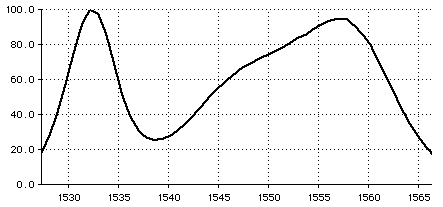
TFCalc has the capability of optimizing the product of the illuminant (EDFA) and the reflectance (or transmittance) of a coating. We want this product, which is the actual output of the filter, to be a flat as possible. As can be seen from the plot shown above, even if the filter reflects (or transmits) a 100% at the endpoints (1527.3 and 1566.3 nm), the output would only be about 20%. Hence, for the entire wavelength range, the flattened output of the filtered EDFA can be no more than 20%. The design becomes somewhat easier if the target output is less than 20%.
Reflection Filter
Tilsch et al studied the reflection filter in their paper. To design such a filter, we started with the initial 100-layer design (HL)^50, where H represents 1.2 QWOT of index 2.25 and L represents 1.2 QWOT of index 1.45. The reference wavelength is 1530 nm. The substrate has index 1.44. We design this for normal incidence; in reality, the filter will be positioned at a small angle. For the optimization target we use
-
EDFA * Reflectance = 17.5% for wavelengths from 1527.3 to 1566.3
A total of 201 equally-spaced targets are used. To make the output as flat as possible, we use power=16 during optimization. The result is a 91-layer design. In white light, the performance of the filter is shown below.
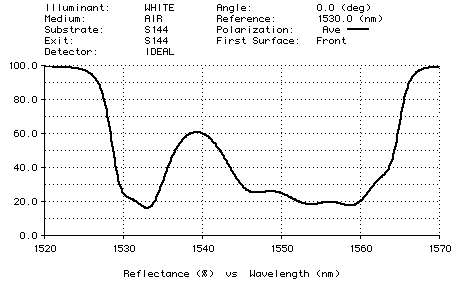
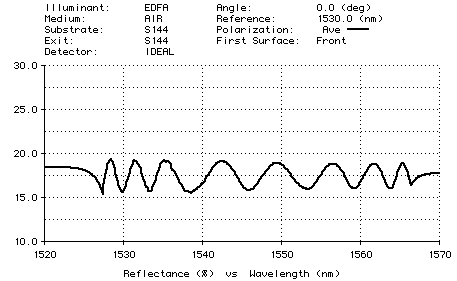
Transmission Filter
To discover whether there is any advantage in using a transmission filter, we decided to design one. Most of the details are the same as for the reflection filter. However, this time we started with the 101-layer design (HL)^50 H. The target is
-
EDFA * Transmittance = 17.5% for wavelengths from 1527.3 to 1566.3
We used one continuous target. Again, we use power=16. By constraining the layer thicknesses to be greater than 0.5 QWOT during optimization, we discover a 101-layer design having a very flat (less than ±0.12 dB) output, as displayed below on a dB scale.
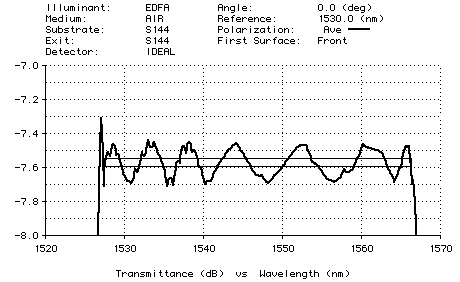
Manufacturability
By randomly varying the thickness of layers, TFCalc can determine the manufacturability of a design. For the designs mentioned in the Tilsch et al paper, a maximum error of 0.05% is required for production. Note that, using this error limit, if a layer is 100 nm thick, then the thickness must be monitored to within ±0.5 angstrom! The plot below shows the range of the performance of the reflection filter for 1000 random designs when layers are allowed to vary uniformly by ±0.05%.
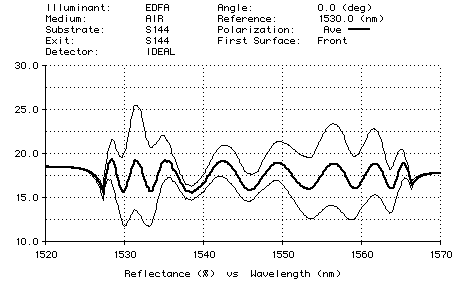
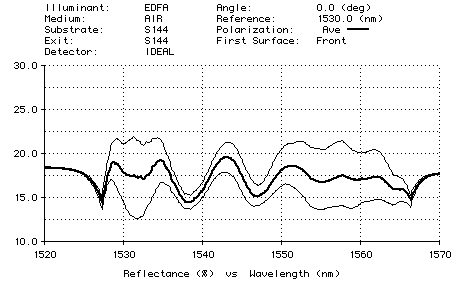
This work is not nearly as exhaustive as in the Tilsch et al paper. However, it does show how optimizing the sensitivity can improve the performance of a design.
Here are the two designs; Design 1 is the original reflection design; Design 2 is the
reflection design optimized for sensitivity. The first layer is closest to the substrate and thickness is given in nm:
Material Design1 Design2 N225 173.22 183.23 N145 266.11 283.45 N225 170.37 187.68 N145 281.70 310.91 N225 241.67 232.70 N145 499.80 486.55 N225 149.42 123.93 N145 216.86 239.55 N225 170.23 182.06 N145 276.29 300.51 N225 162.25 185.72 N145 260.42 264.95 N225 176.10 151.72 N145 249.71 215.61 N225 389.76 404.62 N145 244.24 250.29 N225 176.51 176.04 N145 269.84 258.26 N225 172.68 161.16 N145 351.00 358.60 N225 318.17 316.63 N145 285.93 279.08 N225 158.51 181.70 N145 246.70 282.89 N225 177.51 169.19 N145 290.04 253.96 N225 166.26 165.89 N145 265.69 263.71 N225 187.39 176.44 N145 311.12 322.47 N225 266.31 283.07 N145 353.44 322.81 N225 183.75 179.50 N145 268.79 273.76 N225 177.71 179.47 N145 267.34 275.20 N225 180.82 186.31 N145 265.61 285.18 N225 179.56 191.58 N145 310.69 307.51 N225 201.44 191.85 N145 337.80 335.97 N225 546.46 539.71 N145 419.51 418.70 N225 180.85 182.18 N145 261.04 270.87 N225 173.18 179.08 N145 264.37 276.37 N225 172.93 185.79 N145 264.15 256.11 N225 175.67 168.30 N145 265.07 260.12 N225 178.47 199.99 N145 251.01 244.43 N225 182.79 199.31 N145 596.29 582.84 N225 115.52 114.77 N145 244.92 217.38 N225 173.55 177.19 N145 263.13 271.27 N225 168.53 174.83 N145 265.62 276.17 N225 172.31 179.17 N145 264.86 274.15 N225 175.52 180.52 N145 280.45 288.85 N225 176.08 183.83 N145 243.23 239.70 N225 245.25 215.08 N145 177.49 231.26 N225 358.93 358.44 N145 262.76 255.62 N225 176.24 171.92 N145 245.65 223.47 N225 166.69 160.65 N145 255.30 259.85 N225 165.34 169.67 N145 256.16 275.05 N225 412.72 403.73 N145 239.67 218.93 N225 175.49 175.58 N145 273.85 297.29 N225 140.82 169.58 N145 297.28 309.52 N225 219.98 193.75 N145 493.44 484.74 N225 168.57 157.29 N145 282.43 319.13 N225 175.48 186.11 N145 274.12 303.92 N225 173.02 181.17